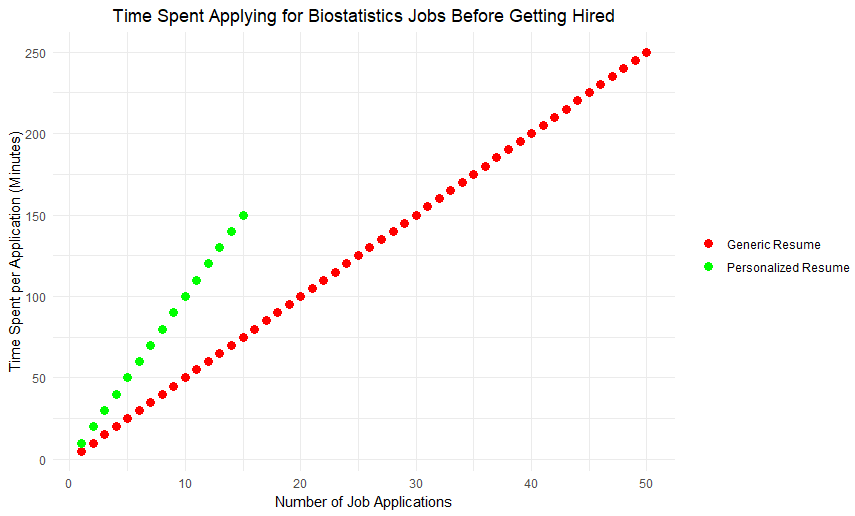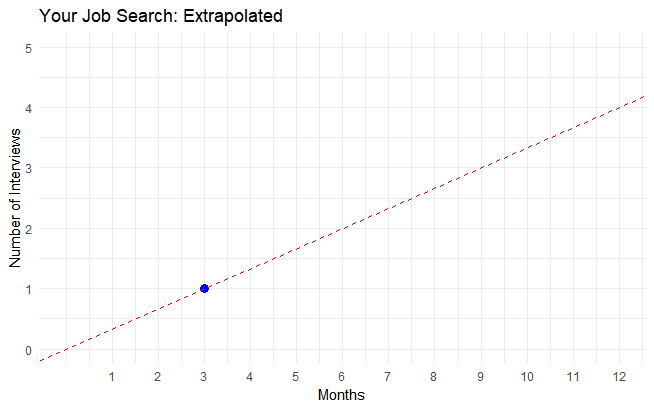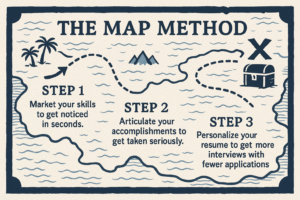
A common mistake when applying to biostatistician jobs is not personalizing your resume to match the specific role you’re applying for.
In this article I’ll highlight why sending a generic resume when applying to biostatistician jobs can hurt your chances and provide practical tips on how to personalize your resume to improve your chances of getting that job.
Why You Shouldn’t Send Your Generic Resume
Sending your generic resume when applying for biostatistician jobs is like trying to hammer in a screw. Sure, it might work in some cases, but it isn’t the best tool for the job. For example let’s say a company is hiring a biostatistician with experience in R, writing SAPs and hypothesis testing. If you apply with a generic resume that highlights your experience in python, data science and NLP, do you think you’re the best fit for the job? I’d say that’s a “no”. If I saw this resume, I’d assume that this applicant wants a data science role but is just applying for this job as a backup, without considering the requirements of this job. Your resume should be selling why you’re a good fit for this job, not listing your skills and experiences that you won’t be using if hired.
Quality Over Quantity
Many biostatisticians believe that applying for more jobs increases their chances of landing one. Sure, you’re increasing your surface area, you’re also spreading your resume too thin over the job market. This is especially problematic when the job market is competitive. When there aren’t many positions available, don’t waste your application. Instead of asking yourself, “How can I apply for more jobs?”, ask yourself, “How can I position myself to be the best match for this job?”. To do this, you need to think about who will be reviewing your resume.
Who’s Reviewing Your Resume?
When you submit your resume, it will likely be reviewed by one or more of the following:
- Applicant Tracking System (ATS)
- Recruiter
- HR
- Hiring Manager
Applicant Tracking System
ATS is used by all the most of the generic job websites. is an automated tool that filters out applications to help employers sort through large volumes of resumes. It does this by comparing your resume with the job advert. See the problem here? If you send a generic resume, it’s likely you won’t make it past this initial filter. If your resume doesn’t match the job advert closely enough, you will be automatically rejected before a human even sees it.
Recruiter/HR
If your resume passes the ATS, it will likely next be reviewed by a recruiter or HR. While this gives you a slightly better chance than ATs, the challenge is that the next person reviewing your resume may not have domain knowledge. They’ll typically scan resumes quickly and might use shortcuts like CTRL+F to search for key skills quickly. You essentially have a human form of ATS here. Again, if you haven’t personalized your resume to align with the job advert, you’ll significantly reduce your chances of hearing back.
Hiring Manager
If your resume reaches the hiring manager, you stand a much better chance of hearing back. Hiring managers have the expertise to evaluate whether your experience is a good fit. They may even look beyond a generic resume if they think your overall experience is valuable. However, with the high volume of applicants that each biostatistician job advert gets, the candidate who best matches the job requirements will always win. If you don’t tailor your resume, you’ll never be the best match for the job.
How To Personalize Your Resume For Biostatistician Jobs
Important reminder: Never lie on your resume. It can potentially lead to you losing the job you’ve been offered, can damage your reputation, and hinder future career opportunities. With that said, let’s move on to the key sections of your biostatistics resume that your should personalize.
What Resume Sections To Personalize
To increase your chances of landing biostatistician jobs, you need to tailor the following sections of your resume to the job’s advert:
- Skills
- Job titles
- Work experience
- Education
- Projects
- Publications
Skills
Most biostatistician job descriptions list the skills they expect the candidates to possess. Make sure your resume reflects these skills – if you have them. For example, don’t list experience in SAS if you’ve only ever worked in R. Feel free to include relevant skills that isn’t listed in the job advert. For example, data cleaning skills will always be relevant even if it’s not mentioned directly in the job description. The goal of this section is to make it easy for the reviewer to quickly scan your resume and confirm that you have the necessary skills for the job. This section doesn’t have to be exhaustive.
Job Titles
Your job title on your contract doesn’t have to be the exact one on your resume. Granted, you shouldn’t exaggerate but a slight adjustment can help. In biostatistics, job titles can vary widely. If your duties align with a biostatistician role, but your title is something like “Research Scientist,” consider listing yourself as a biostatistician.
This is especially important because HR or recruiters may not fully understand the nuances of your role. Changing this section is solely to get through the gatekeepers because the hiring manager will most likely understand your skills matter more than your job title.
Note: If you adjust your job title, make sure your employer would support this change if contacted for a reference.
Work Experience
This section is your opportunity to show the employer that you have the relevant experience to back up the skills. Use results-orientated actions that show how your past work aligns with the job description. For example, if the job ad mentions they’re looking for an applicant with “familiarity with mixed models and repeated measures” and you have experience with these methods, make sure to highlight it. Instead of writing: “Ran linear regression models to quantify dementia progression following intervention.” Write something like: “Applied mixed-effects models to assess within-subject variability in systolic blood pressure fluctuations, showing a 21% higher variability in patients with uncontrolled hypertension over a 12-month follow-up.” Personalizing this section is the most effective way to show you’re the ideal candidate for this role.
Education
Include any relevant coursework or classes that align with the job description but might not be covered elsewhere. For example, if the job asks for “experience with time-series data” and you took a relevant course, mention it here – even if you haven’t yet applied it professionally.
Projects
Similar to the education section, this section allows you to highlight any relevant skills or experiences you may not have shown in other sections. For instance, if you’ve done a self-directed project in survival analysis but haven’t had the chance to apply it in a formal job, this is where to showcase it. This is a perfect area to showcase your skills and experience, especially if you’re looking at landing your first biostatistics job.
Publications
If you have multiple publications, only include those that are most relevant to the role. For example, if the job focuses on oncology, prioritize your publications that are related to cancer research.
How Much Time Will This Take?
When you start personalizing your resume, it should take no more than 20-30 minutes per application. This might sound like a lot of time, but the more you do it, the quicker and easier it gets. Eventually, you’ll be able to personalize your resume in 5-10 minutes. With each new job you apply to, you’ll have a growing collection of tailored resumes and templates that will make the process even faster.
And trust me, the effort is worth it considering how much a personalized resume significantly increases your chances of landing the job.
Conclusion
Pick a random biostatistician job posting. Create a copy of your current resume, and spend just 5 minutes personalizing it for the role. Now, compare your generic resume to the tailored one. Which one would you rather hire?
Ready to Land More Biostatistics Interviews?
Get my free email course that walks you through the exact steps biostatistics professionals are using to get more callbacks, without rewriting their resume 100 times.
- 🔬 Step-by-step, field-tested advice
Tried-and-true strategies designed specifically for biostatistics job seekers. - ✅ Actionable steps you can apply immediately
Each email includes one clear step to help you get noticed and get interviews. - 📬 1 email per day. Zero fluff. Just results.
Short, focused lessons that respect your time—and deliver real value.

